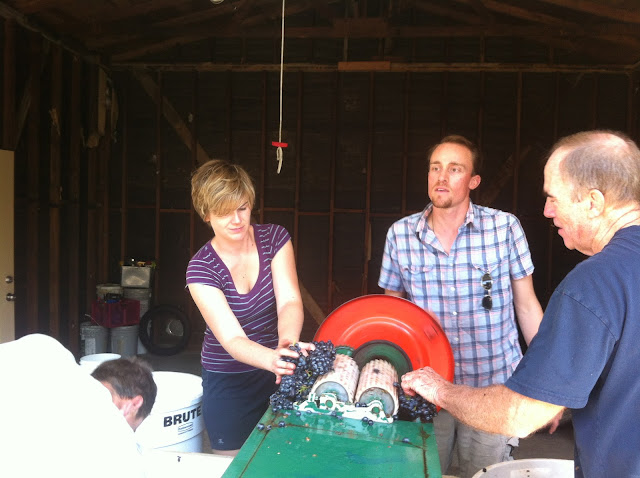When I wrote about the Barbera Harvest there was an important step I neglected to mention because I didn't have the pictures. Special thanks to Todd's mom for chronicling a very tedious process and letting me step back as photographer and jump in to the work. Not that I could have gotten away with being the photographer anyway. There was way too much work to do.
This shows what happens when you make wine at home without a fork lift, or a pallet jack.
Todd and I picked up the Marsanne and Viogner as well as the Teroldego in his truck because they were only half tons each. A full ton of Barbera was not going to fit in his truck, so we had it delivered by the vineyard owner. We didn't really know what the plan was. We had a vague delivery time and no information on how it was going to arrive. We waited outside my house and then a large UHAUL arrived. Turns out he was delivering more than just our Barbera that day.
Dave, the vineyard owner showed up around noon ready to unload the bins, but we had no way of unloading them. Fortunately Dave was a really cool laid back guy and fortunately we had an empty half ton bin. So without a forklift the only thing we could do was transfer all the grapes by hand.
It was a very daunting task.
So Dave, Todd, his dad Bill and myself proceed to grab fistfuls of grapes out of the half ton bins and put them into 5 gallon buckets. Then we emptied the buckets into a 30 gallon brute on wheels and pushed the brute up the driveway towards the other halfton bin.
Another slight exaggeration of Todd's tall-ness and my tiny-ness (and he's hunching over!)
We had to hurry up and get the grapes out of the truck because Dave needed to deliver the remaining grapes to the other buyers. There were 10 bins in the truck and only 2 belonged to us. Dave's go-with-the-flow attitude really helped lower the stress of the situation. He saw we didn't have a forklift and just jumped in and helped move grapes.
Once all the grapes in the top bin had been transferred to the bin on my driveway, we dropped the bin we had just emptied onto the ground repeated the process by emptying the second bin into the first one.
We were just trying to get our grapes off the truck so that Dave could deliver the rest of the load. After an hour we had 2 bins full of grapes on my drive way, but the tank is in the back of the house so it took another hour to hand-transfer the grapes from the front of the house to the back garage. It was a massive leap-frog operation.
A pallet jack would have saved us. Turns out craigslist has them used for about $200.
Live and learn.
Forklifts are a little more expensive.
-L







































